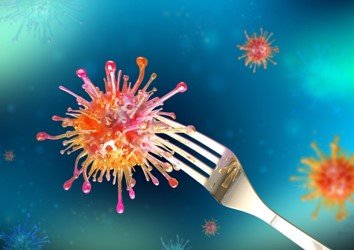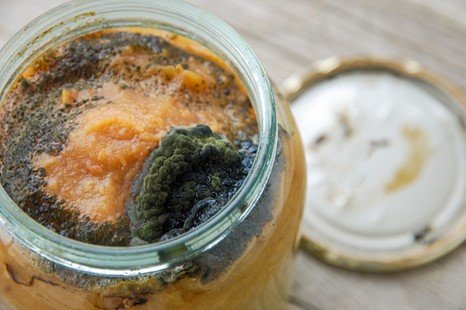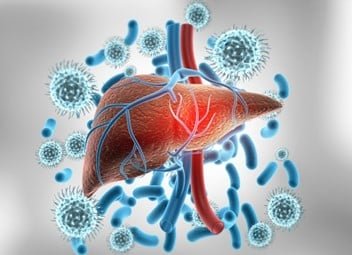Foodborne diseases also called food poisoning are illnesses caused by eating or drinking contaminated food. Researchers have identified more than 250 foodborne illnesses caused by bacteria, viruses, parasites, fungi, chemicals, or toxins in food products. While many of these organisms live in and on our bodies often in harmless, even helpful ways under certain conditions, they can cause life-threatening diseases.
According to the Food and Drug Administration, about one in six Americans, or about 48 million people get food poisoning each year These infections result in an estimated 128,000 hospitalizations and 3,000 deaths across the country each year.3 In addition, the annual cost of all foodborne illnesses in this country is estimated to exceed $17.6 billion in direct medical expenses and lost productivity. so in this article, we will outline some overview of bloodborne Diseases as follows:
- Risk Factors for Foodborne Illnesses
- Symptoms of Foodborne Illnesses
- How Harmful Germs Get into Food
- Preventing Foodborne Diseases
- Germs that Cause Food Poisoning
Also Read: Food and Kitchen Hygiene Tips

Risk Factors for Foodborne Illnesses
Foodborne illness can affect anyone who eats contaminated food. However, certain groups, are more likely to get sick from contaminated food, such as:
- pregnant women;
- older adults;
- young children; and
- people with weakened immune systems.
Symptoms of Foodborne Illnesses
People infected with food poisoning may have no symptoms to very severe symptoms that usually last from one to seven days. The most common symptoms of foodborne illnesses are:
- upset stomach;
- abdominal cramps;
- nausea;
- vomiting;
- diarrhea;
- fever;
- fatigue; and
- joint or backaches.
Also Read: Healthy Eating program at the workplace
While most cases of food poisoning go away on their own within a few hours or days, see a healthcare provider if the following severe symptoms occur:
- bloody diarrhea;
- diarrhea that lasts more than three days;
- body temperature over 102 degrees;
- frequent vomiting that leads to dehydration; or
- dehydration resulting in little or no urination, a parched mouth, a dry throat, or feeling dizzy when standing.
In severe cases, foodborne illnesses can cause long-term health problems or even death. Serious infections without proper medical attention can lead to:
- chronic arthritis;
- brain and nerve damage; or
- kidney failure.
How Harmful Germs Get into Food

Food becomes contaminated in a variety of ways. Among the most common are:
Contamination of food by animal or human waste
- It is normal to find bacteria in the intestines of healthy animals used for food. Meat and poultry can become contaminated by small amounts of intestinal contents during slaughter.
- Fresh fruits and vegetables can get contaminated when water used for irrigation or washing has germs from animal manure or human sewage.
Lack of proper handwashing
- Germs and trace amounts of intestinal contents can be introduced into food when food preparers do not properly wash their hands.
Transferring germs from one surface to another
- Food, kitchen tools, and surfaces may become contaminated by raw food products.
- Germs can transfer from one food to another when the same knife, cutting board, or other utensils are not washed between uses (known as cross-contamination).
- A food that is fully cooked can become re-contaminated if it touches other raw foods or juices from raw food that contain germs.
Storing and cooking at the wrong temperatures

- In general, refrigeration and freezing prevent bacteria from multiplying in large enough numbers to cause foodborne disease. Likewise, proper heating can kill most parasites, viruses, and bacteria.
Preventing Foodborne Diseases
Most foodborne diseases are easy to avoid with these simple steps :
Clean
Wash your hands often and always before touching food. To minimize the risk of food poisoning, always wash the produce before eating or serving it. Keep knives, cutting boards, and kitchen surfaces clean. Wash them with hot, soapy water, or put items in the dishwasher. Use a disinfectant on counters after touching raw meat or poultry.
Separate
Keep germs from the raw meat from getting on fruits, vegetables, and other foods. Put cooked meat on a clean platter, not back on the one that held the raw meat.
Cook
Thoroughly cook meat, chicken, fish, shellfish, and eggs.
Chill
Eat cooked food promptly and refrigerate leftovers within two hours after cooking. Do not leave cut fruits and vegetables at room temperature for a long time.
When in doubt, throw it out
If you aren’t sure if a food is safe, don’t eat it.
Germs that Cause Food Poisoning
Some germs make people sick within a few hours after swallowing them. Others may take several days. Here are a few of the hundreds of germs that can cause foodborne diseases:
Staph (Staphylococcal aureus )
- What is Staph?
Staph food poisoning is an intestinal illness caused by eating foods contaminated with toxins (poison) produced by the Staphylococcus aureus bacteria. About 25% of people and animals have Staph bacteria in the gut. The percentage is even higher if you include those with skin, eye, nose, or throat infections. Usually, Staph does not cause illness in healthy people. However, if the bacteria gets into the bloodstream, it can become severe, even fatal.

Also Read: Photo of the day: Preventing the spread of contagious illness

- • Symptoms begin 30 minutes to eight hours after exposure. Symptoms of Staph may include nausea, vomiting, and stomach cramps. Most people also have diarrhea.
- Common food sources: Handling uncooked foods, such as sliced meats, puddings, pastries, and sandwiches, are a common cause of Staph food poisoning.
- Ways to prevent Staph:
- Do not keep food at an unsafe temperature for more than two hours.
- Always use a food thermometer to ensure food cooks to a safe minimum internal temperature.
- Keep hot foods hot (140 degrees or hotter) and cold foods cold (40 degrees or colder).
- Store cooked food in wide, shallow containers and refrigerate within two hours (or one hour if it is hotter than 90 degrees outside).
Vibrio (Vibriosis)
- What is Vibrio Bacteria
Vibrio bacteria live in certain coastal waters and are present in high concentrations between May and October. About a dozen Vibrio species cause a type of food poisoning called Vibriosis. Certain Vibrio species can also cause skin infections when an open wound is exposed to saltwater or brackish water.
Brackish water is a mixture of fresh and saltwater often found where a river meets the sea.
- Symptoms begin two to 48 hours after exposure.
Symptoms of Vibriosis include watery diarrhea, nausea, stomach cramps, vomiting, fever, and chills.
- Common food sources:
Most people become infected with Vibrio bacteria by eating raw or under-cooked shellfish, particularly oysters.
- Ways to prevent Vibriosis:
- Do not eat raw or undercooked oysters or other shellfish.
- Wear protective gloves when handling raw seafood.
- Wash hands with soap and water after handling raw shellfish.
- Avoid cross-contaminating cooked shellfish with raw shellfish and their juices.
- Stay out of saltwater or brackish water if you have a wound (including recent surgery, piercing, or tattoo). Cover your wound with a waterproof bandage if it might come into contact with salt water, brackish water, raw seafood, or raw seafood juices.
C. perfringens (Clostridium perfringens)
- What is C. perfringens?
C. perfringens is one of the most common causes of food poisoning.5 It is a bacteria that, under unsafe temperature conditions, can grow and multiply on food. When swallowed, it produces a toxin that causes diarrhea.
- Symptoms begin six to 24 hours after exposure.
- Common food sources:
Beef or poultry, especially large roasts, gravies, and dried or pre-cooked foods,are common sources of c. perfringens contamination.
- Ways to prevent C. perfringens:
- Cook food to a safe temperature, especially beef roasts and whole poultry.
- Keep cooked food at 140 degrees or warmer or 40 degrees or colder if it will not be served or eaten soon.
- Refrigerate leftovers at 40 degrees or colder within two hours after cooking the food (or within one hour if the outside temperature is above 90 degrees).
- Reheat leftovers to at least 165 degrees before serving.
Salmonella (Salmonellosis)
- What is Salmonella?
Salmonella is a common bacterial infection that affects the intestinal tract.
- Symptoms begin six hours to six days after exposure.
Symptoms may include diarrhea, fever, stomach cramps, and vomiting.
- Common food sources:
Raw or undercooked chicken, turkey, and meat; eggs; unpasteurized (raw) milk and juice; and raw fruits and vegetables are common sources of contamination. Also, many animals carry Salmonella, including backyard poultry, reptiles and amphibians, and rodents (pocket pets).
Diarrhea and stomach cramps usually begin suddenly with C. perfringens and last for less than 24 hours. Vomiting and fever are not common.
- Ways to prevent Salmonella:
- Drink only pasteurized milk.
- Cook poultry and eggs thoroughly. Cook poultry products to an internal temperature of 170 degrees for breast meat and 180 degrees for thigh meat.
- Avoid foods containing raw eggs, such as homemade Caesar salad dressing, cookie dough, hollandaise sauce, or homemade eggnog.
- Keep eggs refrigerated.
- Throw away cracked or dirty eggs.
- Use soap and hot water to wash all food preparation surfaces and utensils that come in contact with raw poultry or raw eggs.
- Wash hands immediately after handling raw poultry, raw eggs, reptiles, or animal feces (intestinal matter).
Download : E-Books: Occupational Safety and Health Simplified for the Food Manufacturing Industry
Norovirus
- What is Norovirus?
Norovirus is a contagious virus and the leading cause of foodborne illness. It is often called a “stomach flu” or a “stomach bug.” However, it is not related to the flu, which is caused by the influenza virus.
- Symptoms begin 12 to 48 hours after exposure. Symptoms include diarrhea, nausea, stomach pain, and vomiting.
- Common food sources:
Leafy greens, fresh fruits, shellfish (such as oysters), or unsafe water can carry Norovirus. Norovirus is also spread by an infected person or by touching surfaces that have the virus on them.
- Ways to prevent Norovirus:
- Wash hands often.
- Rinse fruits and vegetables.
- Cook shellfish thoroughly.
- Stay home when sick and for two days after symptoms stop.
- Avoid preparing food for others while sick and for two days after symptoms stop.
Botulism (Clostridium botulinum)

- What is Botulism?
Botulism is a rare but serious illness caused by bacteria that can create a toxin that attacks the body’s nerves. This toxin can cause difficulty breathing, muscle paralysis, and even death. This toxin can produce Botulism not only in food but in wounds and the intestines of infants.
Botulism is found naturally in many places but rarely makes people sick. However, the bacteria spores can grow in certain conditions and make one of the most lethal toxins known.7
- Symptoms begin 18 to 36 hours after exposure.
Symptoms may include double or blurred vision, drooping eyelids, slurred speech, difficulty swallowing and breathing, dry mouth, muscle weakness, and paralysis. Symptoms start in the head and move down as the illness worsens.
- Common food sources:
Improperly canned or fermented foods and homemade alcohol are common sources of contamination. Cases of foodborne Botulism often come from home-canned foods with a low acid content, such as asparagus, green beans, beets, and corn. However, infection outbreaks have also come from more unusual sources such as chili peppers, tomatoes, and improperly handled baked potatoes wrapped in aluminum foil.
- Ways to prevent Botulism:
- Follow strict hygiene steps when home canning.
- Refrigerate oils with garlic or herbs.
- Keep foil-covered baked potatoes wrapped and hot until served or refrigerate them.
- Consider boiling home-canned food before eating it to kill any bacteria in the food.
Campylobacter (Campylobacteriosis)
- What is Campylobacter? Campylobacter is a bacteria that can cause a type of food poisoning known as Campylobacteriosis. It is the most common bacterial cause of diarrhea illness in the United States.8
- Symptoms begin two to five days after exposure.
Symptoms include diarrhea (often bloody), stomach cramps, stomach pain, and fever.
- Common food sources:
Raw or undercooked poultry, raw (unpasteurized) milk, and contaminated water are common sources of contamination.
- Ways to prevent Campylobacter:
- Wash hands before preparing food and immediately after handling raw poultry or other meat.
- Thoroughly wash with soap and hot water all food preparation surfaces and utensils that come in contact with raw meat.
- Cook poultry products to an internal temperature of 170 degrees for breast meat and 180 degrees for thigh meat.
- Drink pasteurized milk and chlorinated or boiled water.
- Wash hands after handling pet feces.
E. coli (Escherichia coli)
- What is E. coli?
Escherichia coli (abbreviated as E. coli) are bacteria that typically live in the intestines. This large and diverse group of bacteria plays an important role in a healthy human intestinal tract. However, a few strains cause serious health complications if not properly managed.
- Symptoms begin three to four days after exposure.
Symptoms include severe stomach cramps, diarrhea (often bloody), and vomiting. Around 5–10% of people diagnosed with E. coli may develop kidney failure.9 However, most people recover within a week without medications.
- Common food sources:
Raw or undercooked ground beef, raw (unpasteurized) milk and juice, raw vegetables (such as lettuce), raw sprouts, and unsafe water are common sources of contamination.
- Ways to prevent E. coli:
- Eat only thoroughly cooked beef and beef products.
- Cook ground beef patties to an internal temperature of 160 degrees.
- Avoid unpasteurized juices.
- Drink only pasteurized milk.
- Wash fresh fruits and vegetables thoroughly before eating raw or cooking.
Cyclosporiasis (Cyclospora Infection)
- What is Cyclosporiasis?
Cyclosporiasis is an intestinal illness caused by the microscopic parasite Cyclospora. People can become infected with Cyclospora by consuming food or water contaminated with the parasite. People living or traveling in countries where Cyclosporiasis is common are at increased risk for infection.
- Symptoms begin one week after exposure.
Symptoms include watery diarrhea, loss of appetite, weight loss, stomach cramps, bloating, increased gas, nausea, and fatigue.
- Common food sources:
Cyclospora infection is caused by people ingesting something such as food or water contaminated with feces. Raw fruits or vegetables and herbs are common sources of contamination. It typically needs at least one-to-two weeks after being passed in a bowel movement to become infectious to another person. Therefore, it is unlikely that Cyclospora is passed directly from one person to another.
- Ways to prevent Cyclospora:
- Avoid food or water with possible contamination from human or animal waste.
Listeria (Listeriosis)
- What is Listeriosis?

Listeriosis is a serious infection caused by the germ Listeria, a bacteria found in soil, water, and some animals, including cattle and poultry. People can become ill with Listeriosis after eating contaminated food. However, it primarily affects pregnant women and newborns, older adults, and people with weakened immunity. Listeriosis is usually a mild illness for pregnant women. However, it may cause severe disease in the fetus or newborn baby. Some people with Listeria infections, most commonly adults 65 years and older and people with weakened immune systems, can develop severe infections of the bloodstream (causing sepsis) or brain (causing meningitis or encephalitis). In addition, Listeria infections can sometimes affect other parts of the body, including bones, joints, and sites in the chest and abdomen.
- Symptoms begin one to four weeks after exposure. In pregnant women, Listeria symptoms usually include fever and other flu-like signs, such as fatigue and muscle aches. Infections during pregnancy can lead to serious illness or even death in newborns. Other people (most often older adults) may have symptoms that include a headache, stiff neck, confusion, loss of balance, and convulsions along with fever and muscle aches.
- Common food sources:
Queso fresco and other soft cheeses, raw sprouts, melons, hot dogs, pâtés, deli meats, smoked seafood, and raw (unpasteurized) milk are common sources of contamination.

- Ways to prevent Listeria: High-risk people should:
- Avoid eating soft cheese, such as queso fresco, queso Blanco, panela, brie, Camembert, blue-veined, or feta, unless it is labeled as made with pasteurized milk.
- Do not eat raw sprouts (including alfalfa, clover, radish, and mung bean sprouts), and thoroughly cook all sprouts to kill harmful bacteria.
- Keep cut melon refrigerated at 41 degrees or colder for no more than seven days. Throw away cut melon left at room temperature if left for more than four hours.
- Avoid eating hot dogs, lunch meats, cold cuts, and deli meats (such as bologna), or fermented or dry sausages unless heated to an internal temperature of 165 degrees or until steaming hot just before serving.
- Do not eat refrigerated pâté or meat spreads from a deli or meat counter or the refrigerated section of a store. Meat spreads and pâté that do not need refrigeration before opening, such as products in cans, jars, or sealed pouches, are a safer choice. Always refrigerate these foods after opening.
- Only eat canned, shelf-stable cold-smoked fish or cold-smoked fish cooked in a dish, such as a casserole.
- Consume only pasteurized milk and milk products, including soft cheese, ice cream, and yogurt.
- Keep milk and milk products refrigerated at 40 degrees or colder.
Shigella (Shigellosis or Bacillary Dysentery)
- What is Shigellosis?
Shigella bacteria cause the disease, Shigellosis, most often caused by swallowing food or water contaminated with human or animal waste. Shigella spreads easily. Only a small number of bacteria can make someone ill. People with a Shigella infection can spread the disease to others for several weeks after their symptoms end.
- Symptoms begin one to two days after contact with the germ. Symptoms of Shigella include diarrhea (sometimes bloody), fever, stomach pain, and feeling the need to have a bowel movement even when the bowels are empty. Symptoms usually last five to seven days, but some people may experience symptoms for up to four weeks or more. In some cases, it may take several months before bowel habits (frequency and consistency) are entirely normal.
- Common food sources:
Eating food that was prepared by someone who is sick with Shigellosis can spread the disease. Foods that are consumed raw are more likely to be contaminated with Shigella germs.
- Ways to prevent Shigella infection:
- Avoid swallowing water from ponds, lakes, or untreated swimming pools possibly contaminated with human or animal waste.
- Carefully wash hands with soap and water before eating or preparing food for others, after changing a diaper, or using the restroom.
- Follow travelers’ safe food and water guidelines when traveling internationally.
Hepatitis A
- What is Hepatitis A?

Hepatitis A is an infection of the liver caused by the Hepatitis A virus (HAV). It is highly contagious. However, it is the only common foodborne disease preventable by vaccines. HAV is one of five hepatitis viruses that can infect the liver. While Hepatitis B and C can turn into chronic hepatitis, HAV generally does not, although it can lead to liver failure and death. HAV is a contagious disease that travels in feces. It can spread from person to person or in food or water. In cases of contaminated food, it is usually the person preparing the food who contaminates it. The food handler may not know they have the virus since it is most likely passed on in the first two weeks of illness before a person begins to show symptoms.
- Symptoms usually appear around 28 days after infection but can start as early as two weeks after catching the virus.
Early symptoms of HAV include muscle aches, headache, loss of appetite, abdominal discomfort, fever, weakness, and fatigue. After a few days of experiencing these symptoms, 70% of patients develop jaundice, a yellowing of the skin, eyes, and mucous membranes. Jaundice also causes dark urine and light, clay-colored feces.
- Common food sources:
Although foodborne illnesses caused by HAV are not common in the United States, water, shellfish, frozen produce, and salads are the most common food sources.
- Ways to prevent HAV:
- Get vaccinated. Two vaccine doses are needed for long-term protection, but a single dose of vaccine can prevent infection during an outbreak.
- Wash hands thoroughly with soap and warm water after using the bathroom, changing a diaper, or before preparing food.
- Wash hands with warm water and soap for at least 20 seconds before and after handling raw foods.
- Wash the inside walls and shelves of the refrigerator, cutting boards, countertops, and utensils that may have contact with contaminated foods.
Also Read: E-Books: Food Safety Management-A Practical Guide for the Food Industry
Please visit our Safety Resources SAFETY BAG to have many Safety Resources






